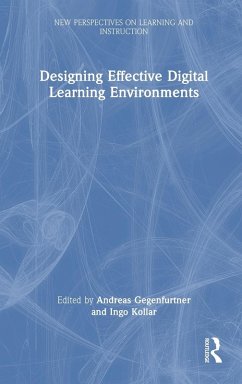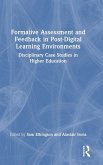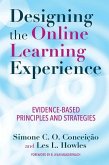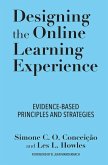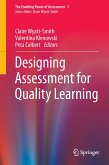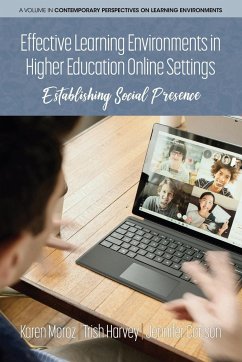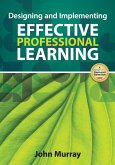Designing Effective Digital Learning Environments
Herausgeber: Gegenfurtner, Andreas; Kollar, Ingo
Designing Effective Digital Learning Environments
Herausgeber: Gegenfurtner, Andreas; Kollar, Ingo
- Gebundenes Buch
- Merkliste
- Auf die Merkliste
- Bewerten Bewerten
- Teilen
- Produkt teilen
- Produkterinnerung
- Produkterinnerung
Bringing together the research of leading international scholars in the field of digital learning, Designing Effective Digital Learning Environments discusses cutting edge advancements in digital technology and presents an evidence-informed summary of best practice for effective design principles and implementation within education.
Andere Kunden interessierten sich auch für
![Formative Assessment and Feedback in Post-Digital Learning Environments Formative Assessment and Feedback in Post-Digital Learning Environments]() Formative Assessment and Feedback in Post-Digital Learning Environments197,99 €
Formative Assessment and Feedback in Post-Digital Learning Environments197,99 €![Designing the Online Learning Experience Designing the Online Learning Experience]() Simone C. O. ConceiçãoDesigning the Online Learning Experience44,99 €
Simone C. O. ConceiçãoDesigning the Online Learning Experience44,99 €![Designing the Online Learning Experience Designing the Online Learning Experience]() Simone C. O. ConceiçãoDesigning the Online Learning Experience171,99 €
Simone C. O. ConceiçãoDesigning the Online Learning Experience171,99 €![Comprehensive Planning for Safe Learning Environments Comprehensive Planning for Safe Learning Environments]() Melissa A. ReevesComprehensive Planning for Safe Learning Environments54,99 €
Melissa A. ReevesComprehensive Planning for Safe Learning Environments54,99 €![Designing Assessment for Quality Learning Designing Assessment for Quality Learning]() Designing Assessment for Quality Learning113,99 €
Designing Assessment for Quality Learning113,99 €![Effective Learning Environments in Higher Education Online Settings Effective Learning Environments in Higher Education Online Settings]() Karen MorozEffective Learning Environments in Higher Education Online Settings48,99 €
Karen MorozEffective Learning Environments in Higher Education Online Settings48,99 €![Designing and Implementing Effective Professional Learning Designing and Implementing Effective Professional Learning]() John MurrayDesigning and Implementing Effective Professional Learning35,99 €
John MurrayDesigning and Implementing Effective Professional Learning35,99 €-
-
-
Bringing together the research of leading international scholars in the field of digital learning, Designing Effective Digital Learning Environments discusses cutting edge advancements in digital technology and presents an evidence-informed summary of best practice for effective design principles and implementation within education.
Produktdetails
- Produktdetails
- Verlag: Routledge
- Seitenzahl: 326
- Erscheinungstermin: 30. Dezember 2024
- Englisch
- Abmessung: 240mm x 161mm x 22mm
- Gewicht: 655g
- ISBN-13: 9781032478197
- ISBN-10: 1032478195
- Artikelnr.: 71299059
- Herstellerkennzeichnung
- Libri GmbH
- Europaallee 1
- 36244 Bad Hersfeld
- gpsr@libri.de
- Verlag: Routledge
- Seitenzahl: 326
- Erscheinungstermin: 30. Dezember 2024
- Englisch
- Abmessung: 240mm x 161mm x 22mm
- Gewicht: 655g
- ISBN-13: 9781032478197
- ISBN-10: 1032478195
- Artikelnr.: 71299059
- Herstellerkennzeichnung
- Libri GmbH
- Europaallee 1
- 36244 Bad Hersfeld
- gpsr@libri.de
Andreas Gegenfurtner is a Professor of Methods in Learning Research at the University of Augsburg. He currently serves as editor of Frontline Learning Research and is on the editorial boards of the EARLI journals Educational Research Review and Learning and Instruction. Ingo Kollar is a Professor of Psychology with a special emphasis on Educational Psychology at the University of Augsburg. He also serves on the editorial boards of Instructional Science, International Journal of Computer-Supported Collaborative Learning, and Psychology Learning and Teaching.
Part I Introduction
1 Design of digital learning environments: Evidence from meta-analyses
Part II Learning with multimedia
2 The effectiveness of learning with multimedia
3 Design of effective digital reading comprehension environments
4 GeoGebra, a comprehensive tool for learning mathematics
Part III Learning with digital videos
5 Dynamic visualizations: How to overcome challenges and seize opportunities
6 Six evidence-informed tips on how to optimize learning from instructional videos
7 Eye movement modeling examples
Part IV Learning from simulated realities
8 Learning with pedagogical agents in digital environments
9 Designing effective immersive virtual reality learning environments
Part V Game-based and sensor-based learning in digital environments
10 Effectiveness of gamification in education
11 Sensors and wearables
Part VI Digital learning in social contexts
12 Computer-supported collaborative learning
13 Social media in class: Problem or panacea?
14 Clickers for effective learning and instruction: An examination of the effects of audience response systems in the classroom
Part VII Designing digital classrooms
15 Effectiveness of flipped classrooms
16 Designing effective synchronous online learning
17 Impacts of web-based inquiry learning environments aligned with knowledge integration pedagogy
Part VIII Discussion
18 Increasing the effectiveness of digital learning
19 Design of digital learning environments: Balancing theoretical, methodological, empirical, and technological approaches
1 Design of digital learning environments: Evidence from meta-analyses
Part II Learning with multimedia
2 The effectiveness of learning with multimedia
3 Design of effective digital reading comprehension environments
4 GeoGebra, a comprehensive tool for learning mathematics
Part III Learning with digital videos
5 Dynamic visualizations: How to overcome challenges and seize opportunities
6 Six evidence-informed tips on how to optimize learning from instructional videos
7 Eye movement modeling examples
Part IV Learning from simulated realities
8 Learning with pedagogical agents in digital environments
9 Designing effective immersive virtual reality learning environments
Part V Game-based and sensor-based learning in digital environments
10 Effectiveness of gamification in education
11 Sensors and wearables
Part VI Digital learning in social contexts
12 Computer-supported collaborative learning
13 Social media in class: Problem or panacea?
14 Clickers for effective learning and instruction: An examination of the effects of audience response systems in the classroom
Part VII Designing digital classrooms
15 Effectiveness of flipped classrooms
16 Designing effective synchronous online learning
17 Impacts of web-based inquiry learning environments aligned with knowledge integration pedagogy
Part VIII Discussion
18 Increasing the effectiveness of digital learning
19 Design of digital learning environments: Balancing theoretical, methodological, empirical, and technological approaches
Part I Introduction
1 Design of digital learning environments: Evidence from meta-analyses
Part II Learning with multimedia
2 The effectiveness of learning with multimedia
3 Design of effective digital reading comprehension environments
4 GeoGebra, a comprehensive tool for learning mathematics
Part III Learning with digital videos
5 Dynamic visualizations: How to overcome challenges and seize opportunities
6 Six evidence-informed tips on how to optimize learning from instructional videos
7 Eye movement modeling examples
Part IV Learning from simulated realities
8 Learning with pedagogical agents in digital environments
9 Designing effective immersive virtual reality learning environments
Part V Game-based and sensor-based learning in digital environments
10 Effectiveness of gamification in education
11 Sensors and wearables
Part VI Digital learning in social contexts
12 Computer-supported collaborative learning
13 Social media in class: Problem or panacea?
14 Clickers for effective learning and instruction: An examination of the effects of audience response systems in the classroom
Part VII Designing digital classrooms
15 Effectiveness of flipped classrooms
16 Designing effective synchronous online learning
17 Impacts of web-based inquiry learning environments aligned with knowledge integration pedagogy
Part VIII Discussion
18 Increasing the effectiveness of digital learning
19 Design of digital learning environments: Balancing theoretical, methodological, empirical, and technological approaches
1 Design of digital learning environments: Evidence from meta-analyses
Part II Learning with multimedia
2 The effectiveness of learning with multimedia
3 Design of effective digital reading comprehension environments
4 GeoGebra, a comprehensive tool for learning mathematics
Part III Learning with digital videos
5 Dynamic visualizations: How to overcome challenges and seize opportunities
6 Six evidence-informed tips on how to optimize learning from instructional videos
7 Eye movement modeling examples
Part IV Learning from simulated realities
8 Learning with pedagogical agents in digital environments
9 Designing effective immersive virtual reality learning environments
Part V Game-based and sensor-based learning in digital environments
10 Effectiveness of gamification in education
11 Sensors and wearables
Part VI Digital learning in social contexts
12 Computer-supported collaborative learning
13 Social media in class: Problem or panacea?
14 Clickers for effective learning and instruction: An examination of the effects of audience response systems in the classroom
Part VII Designing digital classrooms
15 Effectiveness of flipped classrooms
16 Designing effective synchronous online learning
17 Impacts of web-based inquiry learning environments aligned with knowledge integration pedagogy
Part VIII Discussion
18 Increasing the effectiveness of digital learning
19 Design of digital learning environments: Balancing theoretical, methodological, empirical, and technological approaches

